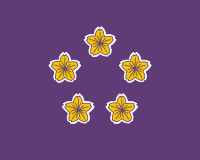Prime Minister of Japan
| Prime Minister of Japan | |
 Emblem of the Prime Minister of Japan |
|
 Taro Aso since 24 September 2008 |
|
| Appointer | the Diet and the Emperor |
|---|---|
| Inaugural holder | Itō Hirobumi |
| Formation | 22 December 1885 |
| Website | www.kantei.go.jp |
| Japan |
 This article is part of the series: |
|
|
|
|
Other countries · Atlas |
The Prime Minister of Japan (内閣総理大臣 Naikaku sōri daijin?) is the usual English-language term used for the head of government of Japan, although the literal translation of the Japanese name for the office is Prime Minister of the Cabinet. The Prime Minister is appointed by the Emperor of Japan after being designated by the Diet from among its members, and must enjoy the confidence of the House of Representatives to remain in office. The Prime Minister is the head of the Cabinet and appoints and dismisses the Ministers of State. Taro Aso has been the prime minister since 24 September 2008.[1]
The office was created in 1885, four years before the enactment of the Meiji Constitution. It took its current form with the adoption of the current constitution in 1947.
Contents |
Appointment
The Prime Minister is designated by both houses of the Diet, before the conduct of any other business. For that purpose, each conducts a ballot under the run-off system. If the two houses choose different individuals, then a joint committee of both houses is appointed to agree on a common candidate. Ultimately, however, if the two houses do not agree within ten days, the decision of the House of Representatives is deemed to be that of the Diet. Therefore, the House of Representatives can theoretically ensure the appointment of any Prime Minister it wishes.[2] The candidate is then formally appointed to office by the Emperor.[3]
The Prime Minister must resign if the House of Representatives adopts a motion of no confidence or defeats a vote of confidence, unless the House of Representatives is dissolved within ten days.[4]
Role
Under Article 5 of the Constitution, the Prime Minister exercises "control and supervision" over the entire executive branch. His countersignature is required for all laws and Cabinet orders.[5] Unlike most other parliamentary systems, where cabinet ministers theoretically have some freedom of action (within the limits of collective responsibility), the Japanese Cabinet is little more than an extension of the Prime Minister's authority.
The Prime Minister appoints all Cabinet ministers, and can dismiss them at any time.[6] He can also permit legal action to be taken against them.[7] He also must make reports on domestic and foreign relations to the Diet.[8] Under the Self-Defense Forces Act of 1954, the Prime Minister is commander in chief of the Japan Self-Defense Forces.
Insignia
History
After the Meiji Restoration, the Daijō-kan system, which was used in the Nara period, was adopted as the Japanese government entity. Political powers of their leader, Daijō Daijin and his aids, Sadaijin and Nadaijin were ambiguous and frequently conflicted with other positions such as Sangi. In the 1880s, Itō Hirobumi, then one of Sangi, started to examine the reformation of the governmental organization. In 1882, Ito and his staff, Ito Miyoji and Saionji Kinmochi, traveled to Europe and investigated constitutions in constitutional monarchies, the British Empire and the German Empire. After his return to Japan, Ito urged the need of a Constitution and a modern governmental system and persuaded conservatives to approve his plan.
On 22 December 1885, in the Daijō-kan order No. 69, abolition of Daijō-kan and the induction of the Prime Minister (内閣総理大臣) and his cabinet were published.
Official office and residence
The Office of the Prime Minister of Japan is called the Kantei (官邸). The original Kantei served from 1929 until 2002. A new building was inaugurated at this time and now serves as the new Kantei.[9] The old Kantei was then converted to the new official residence, or Kōtei (公邸).[10]
Living former Japanese Prime Ministers
- Yasuhiro Nakasone (born 27 May 1918)
- Toshiki Kaifu (born 2 January 1931)
- Morihiro Hosokawa (born 14 January 1938)
- Tsutomu Hata (born 24 August 1935)
- Tomiichi Murayama (born 3 March 1924)
- Yoshiro Mori (born 14 July 1937)
- Jun'ichirō Koizumi (born 8 January 1942)
- Shinzō Abe (born 21 September 1954)
- Yasuo Fukuda (born 16 July 1936)

See also
- List of Prime Ministers of Japan
- Politics of Japan
- History of Japan
- Parliamentary system
References
- ↑ "Taro Aso is named Japan's next prime minister". Retrieved on 2008-09-24.
- ↑ Article 67 of the Constitution of Japan
- ↑ Article 6 of the Constitution of Japan
- ↑ Article 69 of the Constitution of Japan
- ↑ Article 74 of the Constitution of Japan
- ↑ Article 68 of the Constitution of Japan
- ↑ Article 75 of the Constitution of Japan
- ↑ Article 72 of the Constitution of Japan
- ↑ Nakata, Hiroko (2007-03-06). "The prime minister's official hub", The Japan Times Online, The Japan Times. Retrieved on 2007-10-21.
- ↑ "A virtual tour of the former Kantei - Annex etc. - The Residential Area". Prime Minister of Japan. Retrieved on 2007-10-21.
External links
- Prime Minister of Japan and His Cabinet. Official website.
- (Japanese) List of Japanese cabinets 1885 to 1989.
|
||||||||||||||
